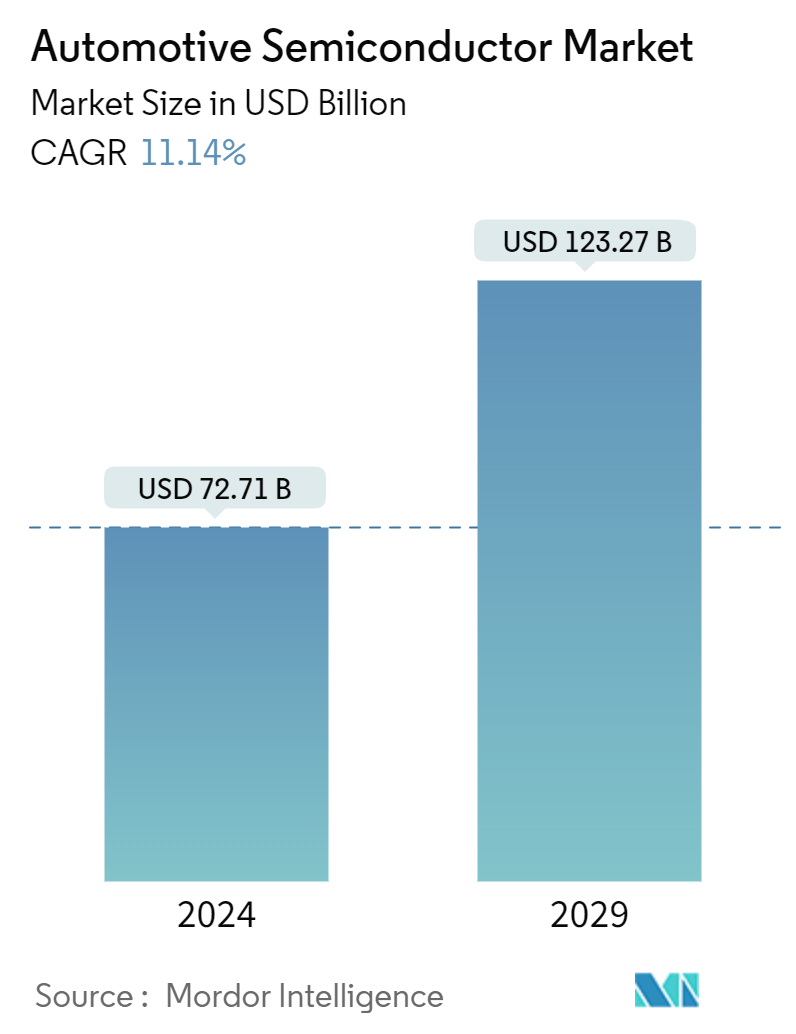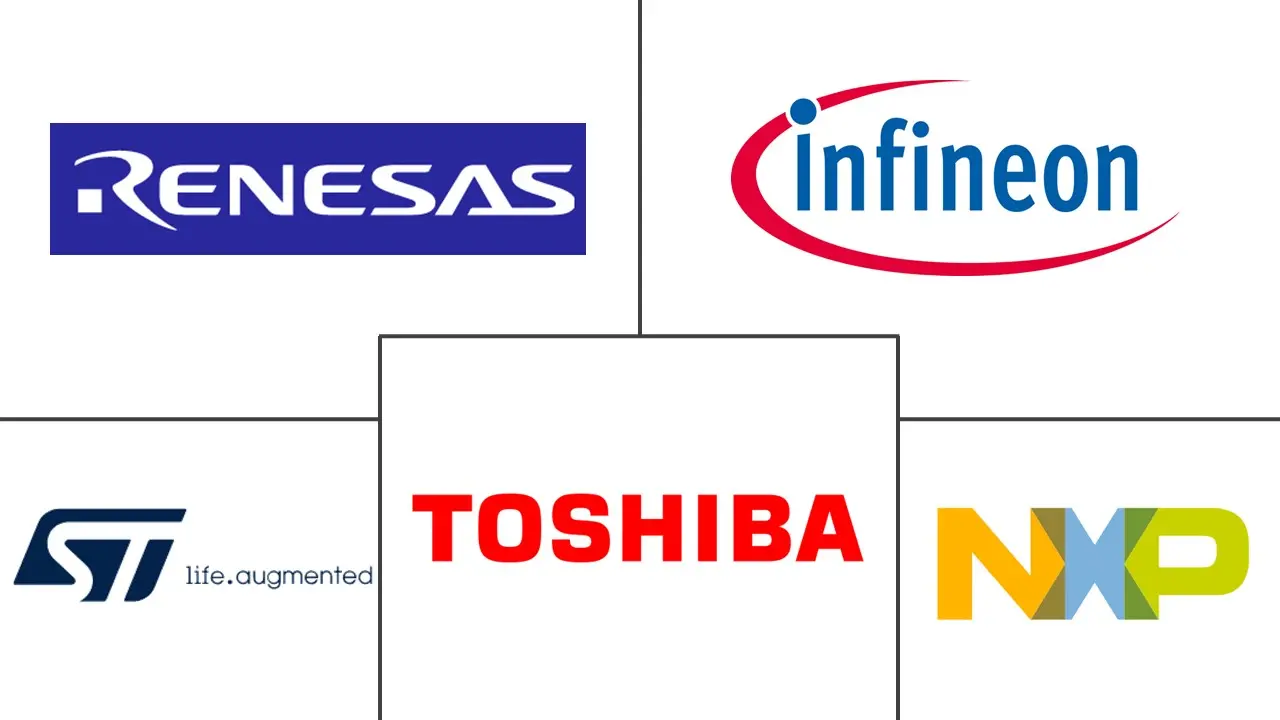Market Size of Automotive Semiconductor Industry

| Study Period | 2019 - 2029 |
| Market Size (2024) | USD 72.71 Billion |
| Market Size (2029) | USD 123.27 Billion |
| CAGR (2024 - 2029) | 11.14 % |
| Fastest Growing Market | Asia Pacific |
| Largest Market | Asia Pacific |
Major Players*Disclaimer: Major Players sorted in no particular order |
Automotive Semiconductor Market Analysis
The Automotive Semiconductor Market size is estimated at USD 72.71 billion in 2024, and is expected to reach USD 123.27 billion by 2029, growing at a CAGR of 11.14% during the forecast period (2024-2029).
- The automobile industry has transformed rapidly over the past few years with the advent of numerous advanced technologies, such as 3D mapping applications, electric vehicles, and automobile automation. This has increased the demand for several advanced semiconductors, including sensors, memory devices, ICs, and many more.
- Growth in automotive semiconductor sales globally mainly depends on vehicle sales and production trends, along with the increase in semiconductor deployment per vehicle, driven by the proliferation of electronic elements throughout the car. Due to the high degree of regulatory scrutiny and safety requirements worldwide, the automotive semiconductor market is characterized by zero-defect quality processes, stringent qualification processes, functionally safe design architecture, extensive design-in timeframes, high reliability, and long product life cycles, which would lead to significant demand for semiconductors in the automotive sector.
- According to the International Organization of Motor Vehicle Manufacturers (OICA), in 2023, over 93 million automobiles were manufactured worldwide. This was an increase of around 10% from 2022. The COVID-19 pandemic led to various changes in car buying behavior and customer attitudes. People readily accept digital services and features to stay connected, safe, and trackable.
- Hence, the increasing penetration of in-vehicle screens is expected to lead to the easy integration of many other digital features. Virtual assistants, voice recognition, personalization, and gesture control may also experience increased demand for growing concerns over touching surfaces. The automotive market is racing toward standardization, and A-PHY (serializer-deserializer (SerDes) physical layer interface) is expected to be the leading connectivity solution. The automotive ecosystem is merging around this standard, and it is expected that A-PHY will soon become a dominant connectivity solution in cars worldwide. However, the automotive semiconductor market is likely to face compelling challenges because of operating flaws in climatic conditions like extreme cold and heat.
- Post-COVID-19, various companies in the market are involved in different strategies, such as launches, acquisitions, and mergers, to gain a competitive edge.
Automotive Semiconductor Industry Segmentation
The market for automotive semiconductors was evaluated by analyzing the market sizes of different components used in the automotive industry, such as sensors, processors, memory devices, discrete power devices, and integrated circuits. The report’s scope comprises analyzing various vehicle types worldwide, including light commercial vehicles, heavy commercial vehicles, and passenger vehicles.
The automotive semiconductor is segmented by vehicle type (passenger vehicle, light commercial vehicle, and heavy commercial vehicle), component (processors, sensors, memory devices, integrated circuits, discrete power devices, and RF devices), application (chassis, power electronics, safety, body electronics, comfort/entertainment unit, and other applications), and geography (North America, Europe, Asia-Pacific, Latina America, and Middle East & Africa). The report offers the market size in value terms in USD for all the abovementioned segments.
| By Vehicle Type | |
| Passenger Vehicle | |
| Light Commercial Vehicle | |
| Heavy Commercial Vehicle |
| By Component | |
| Processors | |
| Sensors | |
| Memory Devices | |
| Integrated Circuits | |
| Discrete Power Devices | |
| RF Devices |
| By Application | |
| Chassis | |
| Power Electronics | |
| Safety | |
| Body Electronics | |
| Comforts/Entertainment Unit | |
| Other Applications |
| By Geography*** | |
| North America | |
| Europe | |
| Asia | |
| Australia and New Zealand | |
| Latin America | |
| Middle East and Africa |
Automotive Semiconductor Market Size Summary
The automotive semiconductor market is experiencing significant growth, driven by the rapid transformation of the automobile industry through advanced technologies such as electric vehicles, automation, and 3D mapping applications. This evolution has led to an increased demand for sophisticated semiconductors, including sensors, memory devices, and integrated circuits, which are essential for the proliferation of electronic components in vehicles. The market's expansion is closely tied to global vehicle sales and production trends, as well as the rising deployment of semiconductors per vehicle. The industry is characterized by stringent quality and safety standards, necessitating zero-defect processes and high reliability, which further fuels the demand for automotive semiconductors. The integration of digital features like in-vehicle screens, virtual assistants, and gesture control systems is also contributing to market growth, as consumers increasingly prioritize connectivity and safety.
The Asia-Pacific region is a focal point for the automotive semiconductor market, propelled by increased manufacturing activities and partnerships between automotive original equipment manufacturers (OEMs) and semiconductor companies. The region's growth is further bolstered by the rising demand for electric and autonomous vehicles, which require a higher number of semiconductors compared to traditional vehicles. The market is witnessing a surge in luxury and semi-luxury vehicles, with global automakers enhancing their offerings with advanced electronic components. Legislative measures in Europe, North America, and Asia-Pacific mandating advanced driver assistance systems (ADAS) are expected to drive further demand for automotive semiconductors. Key players in the market, such as NXP Semiconductor NV, Infineon Technologies AG, and Renesas Electronics Corporation, are actively engaging in strategic collaborations and technological advancements to maintain their competitive edge and meet the growing demand for automotive semiconductors.
Automotive Semiconductor Market Size - Table of Contents
-
1. MARKET INSIGHTS
-
1.1 Market Overview
-
1.2 Industry Attractiveness - Porter's Five Forces Analysis
-
1.2.1 Bargaining Power of Suppliers
-
1.2.2 Bargaining Power of Consumers
-
1.2.3 Threat of New Entrants
-
1.2.4 Intensity of Competitive Rivalry
-
1.2.5 Threat of Substitute Products
-
-
1.3 Industry Value Chain Analysis
-
1.4 Assessment of the Impact of COVID-19 and Other Macroeconomic Trends on the Market
-
1.5 Overview of RF Device Demand in Autonomous Vehicles
-
-
2. MARKET SEGMENTATION
-
2.1 By Vehicle Type
-
2.1.1 Passenger Vehicle
-
2.1.2 Light Commercial Vehicle
-
2.1.3 Heavy Commercial Vehicle
-
-
2.2 By Component
-
2.2.1 Processors
-
2.2.2 Sensors
-
2.2.3 Memory Devices
-
2.2.4 Integrated Circuits
-
2.2.5 Discrete Power Devices
-
2.2.6 RF Devices
-
-
2.3 By Application
-
2.3.1 Chassis
-
2.3.2 Power Electronics
-
2.3.3 Safety
-
2.3.4 Body Electronics
-
2.3.5 Comforts/Entertainment Unit
-
2.3.6 Other Applications
-
-
2.4 By Geography***
-
2.4.1 North America
-
2.4.2 Europe
-
2.4.3 Asia
-
2.4.4 Australia and New Zealand
-
2.4.5 Latin America
-
2.4.6 Middle East and Africa
-
-
Automotive Semiconductor Market Size FAQs
How big is the Automotive Semiconductor Market?
The Automotive Semiconductor Market size is expected to reach USD 72.71 billion in 2024 and grow at a CAGR of 11.14% to reach USD 123.27 billion by 2029.
What is the current Automotive Semiconductor Market size?
In 2024, the Automotive Semiconductor Market size is expected to reach USD 72.71 billion.


